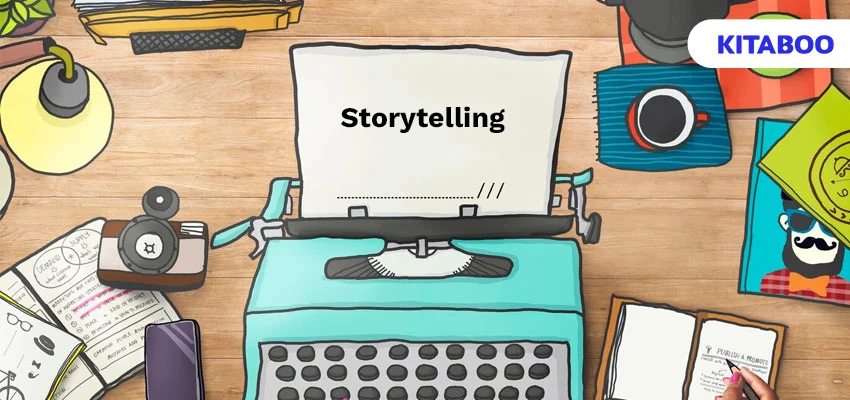
The Art of Storytelling: Creating Compelling Narratives in Publishing
Summarize this blog with your favorite AI:
Digital publishing has transformed the publishing industry, widening the scope for content development and distribution. However, with so much content being published, authors and content creators need to make their content stand out.
Storytelling is a great technique for creating compelling narratives in publishing that capture and retain readers’ attention. Weaving a story can help you ensure your content resonates with readers and leaves an impact.
This article will cover the key elements of good storytelling and techniques to create compelling narratives and empowering content.
Table of Contents
I. Key Elements of Good Storytelling
II. Techniques to Create Compelling Stories
- Show Instead of Telling
- Draw on Personal Experience
- Use Dialogue As a Tool
- Use Foreshadowing
- Flashbacks and Flash-forwards
- Use Symbolism to Convey Meaning
- A Striking Opening
- An Impactful Conclusion
III. To Conclude
Key Elements of Good Storytelling
Understanding the key elements of good storytelling will help you craft engaging narratives.
1. Characters
Characters play a significant role in any narrative. They help advance the story, face challenges, and change through the course of the story.
If your characters are well-developed and relatable, it helps readers emotionally connect with the story and find it absorbing. Complex characters with their unique motivations and goals pique the readers’ interest.
Whether it’s the protagonist, villain, or supporting characters, their personalities, flaws, motivations, and evolution can make the story nuanced and authentic.
2. Plot
The plot is the skeleton of a narrative that delineates or sketches the sequence of events. It sets up the beginning, develops tension, and winds up in a resolution.
A good plot keeps the audience engrossed and curious to know what happens next. It should also have a clear structure with defined obstacles and a satisfying resolution that ties up loose ends.
3. Setting
The setting of a story includes the time, place, and background or context in which it takes place. It allows the reader to imagine the world in which the characters live.
A properly described setting can conjure a different period in history, different places, or even fantasy worlds. A vivid setting can help make the narrative more authentic and life-like. Describe not just sights but also sounds, smells, and textures to bring them to life.
KITABOO‘s K12 publishing integrates multimedia content like images, audio, video, and augmented reality to build an immersive experience for users. This allows for empowering content creation, content development, and digital education.
4. Conflict
Conflict helps drive a narrative by creating tension and challenges for the characters and keeping the reader invested in the outcome.
Whether it’s an internal conflict within the character, a personal struggle a character is facing, or an actual conflict between characters (an external conflict), conflict brings depth to the story. It makes it more absorbing, preventing monotony.
It also helps in character development, bringing issues to the fore, resolving issues, and exploring complexities.
5. Theme
A narrative’s theme contains its underlying idea or message. It brings a deeper level of meaning to the events that take place. More importantly, it ties the story together. By exploring universal themes, narratives resonate with readers and stimulate thought-provoking discussions.
A properly developed theme enriches the story and gives it a sense of purpose so that it is not just a sequence of events but a more meaningful experience.
Techniques to Create Compelling Stories
Here are some useful techniques that help with creating compelling narratives for publishing.
1. Show Instead of Telling
Instead of explicitly stating what a character is feeling or what is going on, show the audience through descriptions and sensory details. This allows you to evoke the reader’s emotions and interpretive imagination and create a more immersive experience.
2. Draw on Personal Experience
Drawing on personal experiences can help make a narrative more compelling, authentic, and relatable for readers. It also enables you to create a story that is unique and effective.
3. Use Dialogue As a Tool
Dialogue is a useful tool to develop characters and move the plot forward. Through dialogue, you can bring out personalities, emotions, and relationships between characters.
Dialogue is also a way to build tension and conflict, making the story engaging. It’s vital to make dialogue natural and authentic so that the story is believable. This could involve using slang or short forms and other colloquialisms to make realistic conversations.
While dialogues can reveal important information, avoid dumping information in dialogues. Dialogue also makes a narrative more interactive and engaging.
KITABOO’s K12 publishing platform allows you to make learning interactive with MCQs, flashcards, learning goals, and chapter summaries.
4. Use Foreshadowing
Foreshadowing is a great technique to create suspense and tension. It hints at themes or events that occur further in the story, evoking expectation and even unease about upcoming twists.
However, keep it subtle to keep readers guessing. Foreshadowing adds complexity and symbolism to the narrative.
5. Flashbacks and Flash-forwards
These transport the reader to a different point in time in the story. Flashbacks offer insights into past events, character backgrounds, or important incidents.
Flash-forwards offer glimpses into future events. These techniques are a useful way to break the monotony of a linear narrative as well as throw light on past incidents with hindsight.
6. Use Symbolism to Convey Meaning
Symbolism uses objects, actions, or elements to represent meaning underlying the literal representation. This layers the story with scope for interpretation.
Symbols also evoke emotions, convey abstract elements, and tie up with larger themes. It also makes the story metaphorically rich and prompts the audience to analyze and reflect on the content.
7. A Striking Opening
The opening of a book or the beginning of a piece of content creates a first impression on readers. It can capture their interest and make them keen to read the rest. An eye-catcher opening could be an intriguing or compelling scene or a sentence that grabs the audience’s attention.
8. An Impactful Conclusion
A good conclusion creates a lasting impact on readers and makes them want to read more of your published content. One way to do this is to end with a twist – a sudden revelation that alters the understanding of the story.
A satisfying conclusion resolves the different themes or streams in the story. You can also end with a cliffhanger – a moment of suspense that leaves readers keen to know what happens next.
To Conclude
For creating compelling narratives in publishing, it’s a good idea to understand the key ingredients of a good story: character, plot, setting, conflict, and theme.
For empowering content creation, content development, and publishing, don’t forget to apply techniques like showing instead of telling, using dialogue as a tool, foreshadowing, symbolism, flashbacks, and more.
If you’re interested in creating engaging and empowering K12 content, check out KITABOO‘s publishing platform. With the latest technologies, it helps you create an immersive reading experience.
Its AI-powered assistant helps you easily create interactive elements like MCQs and flashcards. It also offers a built-in analytics tool to track course activity and gauge readers’ interest levels.
Request a demo to find out more!
Discover how a mobile-first training platform can help your organization.
KITABOO is a cloud-based platform to create, deliver & track mobile-first interactive training content.


